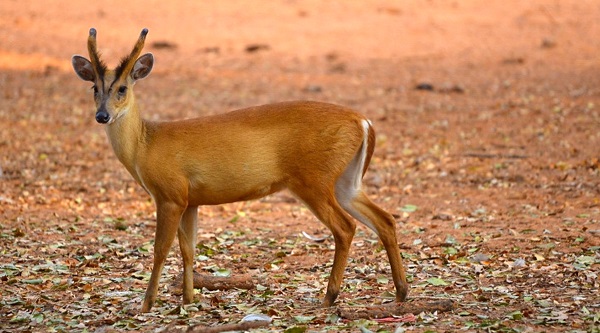Forest Department officials found Indian Muntjac in Asifabad forests after 25 years
Thu 13 Jan 2022, 07:43:52

Kumram Bheem Asifabad: Forest department officials in this district are elated, after they recorded the movement of Indian Muntjac, also known as barking deer in the jungles of this district. The recorded sighting assumes significance as last time these deers were recorded was a quarter century ago.
“Movement of the shy herbivore was recorded in a CCTV camera trap set in Kaghaznagar forest division a few days ago. The officials checked the camera trap on Tuesday and were surprised to find the pictures of the Indian Muntjac. It was sighted for the first time in the erstwhile Adilabad district after a gap of nearly 25 years,” Kaghaznagar forest division officer Vijay Kumar told media.
The discovery has enthused the forest department officials to no end. “The maiden migration of the Indian Muntjac to the wild of the district is certainly a welcoming sign. It reflects sustained efforts made by the department to protect flora and fauna of the region in the past three years,” Penchikalpet Forest Range Officer S Venugopal opined.
Professor Dr Chelmala Srinivasulu of Zoology department of Osmania University said that the Indian Muntjacs are also known as ‘Kakar’ (pronounced kaa-kad) and
primarily browse and nibble on fresh leaves, fruits, and shrubs. It is found across southern India, including the Western Ghats, in the dry forests of central India, the evergreen temperate forests of the Himalayas and the dense rainforests of northeast India.
primarily browse and nibble on fresh leaves, fruits, and shrubs. It is found across southern India, including the Western Ghats, in the dry forests of central India, the evergreen temperate forests of the Himalayas and the dense rainforests of northeast India.
According to him, the general nature of these animals is a bit skittish, as they are prey for a variety of carnivores in the jungles, ranging from tigers to crocodiles. When they encounter such predators or sense the presence of one, they let out the familiar, harsh barking call almost akin to a dog’s. The sound is loud enough to be heard at least a kilometre away, and that’s what gives this deer its name.
Srinivasulu said the animals are a quiet and solitary species. Unlike other deer which often live in herds, Indian Muntjacs are generally alone, with a mate, or females are with a fawn aged up to six months. They mark territory with secretions from glands on their face (below the eyes), as well as by scraping the ground, grass, and tree bark; males are known to use both their hooves and canines.
It is interesting to note that the forest tracts in this district have attracted tigers from the neighbouring Maharashtra in the recent times.
No Comments For This Post, Be first to write a Comment.
Most viewed from Hyderabad
Most viewed from World
AIMIM News
Latest Urdu News
Most Viewed
May 26, 2020
Where should be the burial of the pilgrims martyred in the Saudi Arabia bus accident?
Latest Videos View All
Like Us
Home
About Us
Advertise With Us
All Polls
Epaper Archives
Privacy Policy
Contact Us
Download Etemaad App
© 2025 Etemaad Daily News, All Rights Reserved.
























.jpg)












.jpg)
.jpg)
.jpg)


